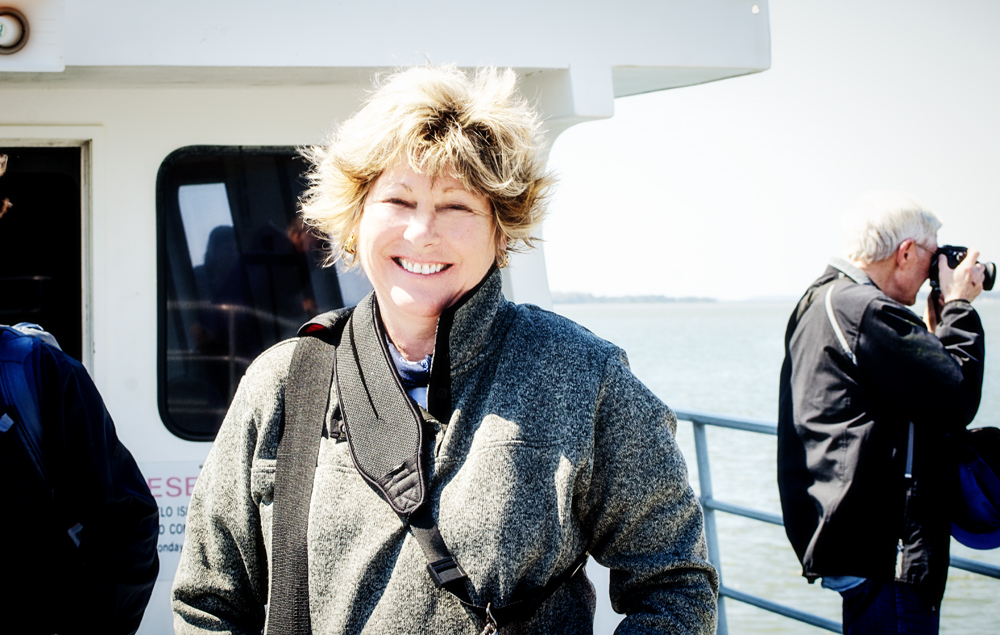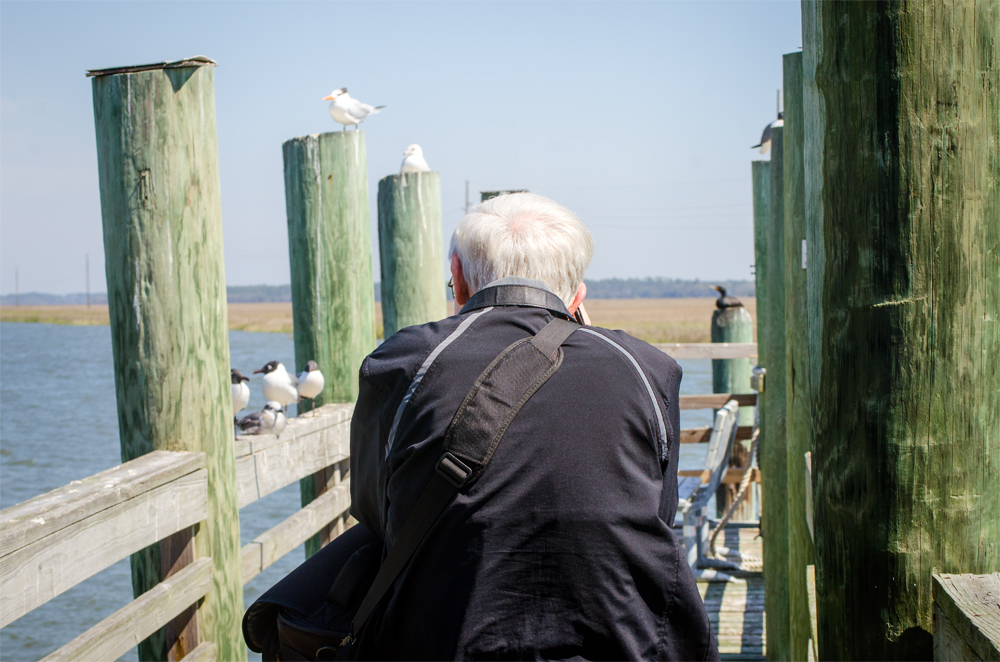 This is always my first view of Sapelo Island from the ranger station on the mainland on the coast of Georgia. Marshes and entangling waterways separate the barrier islands from the mainland.
This is always my first view of Sapelo Island from the ranger station on the mainland on the coast of Georgia. Marshes and entangling waterways separate the barrier islands from the mainland.
 And this is one of my favorite views—leaving the dock for the island. The water is a rich blue in morning and the color of the ferry house provide reflections of the day to come.
And this is one of my favorite views—leaving the dock for the island. The water is a rich blue in morning and the color of the ferry house provide reflections of the day to come.
 Then there’s the arrival on Sapelo. There is a mystery surrounding all of our barrier islands. If you allow your mind to go, you can quickly imagine these waters being sailed by pirates, explorers, and wealthy land owners, who came to Georgia looking to establish large plantations or places of escape for northern winters.
Then there’s the arrival on Sapelo. There is a mystery surrounding all of our barrier islands. If you allow your mind to go, you can quickly imagine these waters being sailed by pirates, explorers, and wealthy land owners, who came to Georgia looking to establish large plantations or places of escape for northern winters.
 Like Sapelo Island, every barrier island had a lighthouse to warn sea captains to stay clear of the shallow coastal waters.
Like Sapelo Island, every barrier island had a lighthouse to warn sea captains to stay clear of the shallow coastal waters.
 Pat doesn’t look like she is enjoying her morning “meal bar” but she is and meal bars work perfectly on island hikes.
Pat doesn’t look like she is enjoying her morning “meal bar” but she is and meal bars work perfectly on island hikes.
 Anne smiles on the way over on the boat. Notice that we started the day with jackets but by the afternoon, those were quickly removed.
Anne smiles on the way over on the boat. Notice that we started the day with jackets but by the afternoon, those were quickly removed.
 This time we toured a small research lab that the state has for elementary education students. The skulls in this photo are of Loggerhead Sea Turtles that come to Coastal Georgia and South Carolina to lay their eggs. The waters are warmer here and the babies once they hatch have a better chance of survival.
This time we toured a small research lab that the state has for elementary education students. The skulls in this photo are of Loggerhead Sea Turtles that come to Coastal Georgia and South Carolina to lay their eggs. The waters are warmer here and the babies once they hatch have a better chance of survival.
 These are old fishing floats that are not used anymore. They have been replace by ones that are all white, which leaves me thinking that we have lost some of the charm that comes with placing nets in the ocean.
These are old fishing floats that are not used anymore. They have been replace by ones that are all white, which leaves me thinking that we have lost some of the charm that comes with placing nets in the ocean.
 I don’t know why I took this photo. I just like the thought of someone taking time to place a small wreath on the wall of this tiny portion of a building that once was a part of the sugar cane industry.
I don’t know why I took this photo. I just like the thought of someone taking time to place a small wreath on the wall of this tiny portion of a building that once was a part of the sugar cane industry.
 Here are some of the original Tabby walls. The best way to explain Tabby is that it is a type of concrete made by burning oyster shells to create lime and then mixing it with water, sand, ash, and on Sapelo Island other broken shells. Many of the islands used only oyster shells but on this island the Tabby contains a mixture of what was available. Historians believe Tabby originated with Spanish settlers. We also know that English colonists primarily in coastal Georgia and South Carolina built Tabby-walled houses.
Here are some of the original Tabby walls. The best way to explain Tabby is that it is a type of concrete made by burning oyster shells to create lime and then mixing it with water, sand, ash, and on Sapelo Island other broken shells. Many of the islands used only oyster shells but on this island the Tabby contains a mixture of what was available. Historians believe Tabby originated with Spanish settlers. We also know that English colonists primarily in coastal Georgia and South Carolina built Tabby-walled houses.
While the process is very labor intensive, it produced a safe dwellings that were warm during winter months when coastal winds are strong and blustery and cool in the summer months when the humidity and mid-day heat is high. During the 19th century, there was a revival in the use of tabby. It was normally protected with a coating of plaster or stucco to stem off quick deterioration. Due to weather extremes, living on coastal Georgia includes constant care of any structure.
 So we have a modern mailbox but a very old lock that was worthy of a photograph!
So we have a modern mailbox but a very old lock that was worthy of a photograph!
 Gulls follow the boats because the engines churn up the water and fish come to the surface. If the gull is lucky, dinner or lunch or breakfast can include a few coastal shrimp!
Gulls follow the boats because the engines churn up the water and fish come to the surface. If the gull is lucky, dinner or lunch or breakfast can include a few coastal shrimp!
 These guys were waiting for the ferry to leave for the mainland.
These guys were waiting for the ferry to leave for the mainland.
 Goodbye Sapelo! Next time we’ll go to the north end of the island and tour “Chocolate” a large plantation.
Goodbye Sapelo! Next time we’ll go to the north end of the island and tour “Chocolate” a large plantation.









Leave A Comment